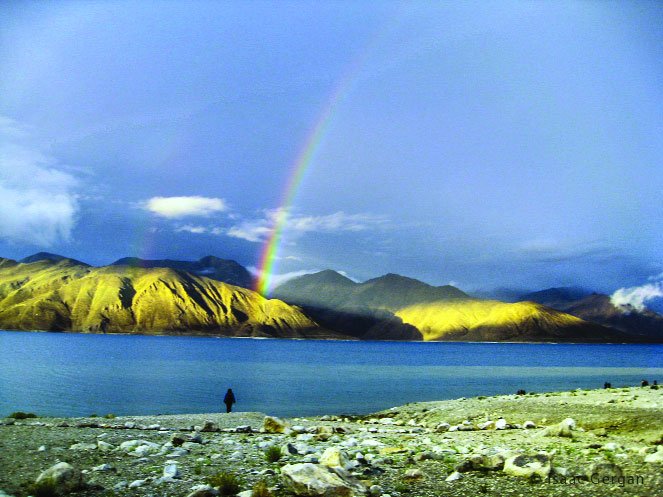Himalayan light is constantly communicable to the eye. In such a landscape, it is a struggle to capture that one special image, says Isaac Tsetan Gergan, who has photographed ladakh extensively. Head to IIC
The camera is a tool, which allows endless experimentation and play to the user, just like the paintbrush does to an artist or a pen to a writer. Its constant use allows for steady growth and also surprises one with the results. I have been fascinated with the idea of capturing images, making the large, immensely fascinating world my own from as long as I can remember. From experimenting with countless point and shoots, early mobile phone cameras and manual film cameras, I have captured my experiences.
Along with my passion of image-making, my sense of photography evolved and diversified at Emily Carr University of Art and Design in Vancouver, BC. The photograph and the act of making it has advanced since then to become in a way, that mnemotechnic extension of my philosophy, allowing me to bridge my many interests.
Photographing ladakh has been one of the most rewarding experiences. Be it taking the camera on a walk, a trek or on a drive, the ever-changing Himalayan light is constantly communicable to the eye. In such a landscape, I still struggle to capture that one special image. I am on a constant journey then to look for that image, where light which marries what it touches in perfect harmony. And along the way, I have managed to capture some, which will always be special.
The Pangong Tso (lake) is one of the highest saltwater lakes in the world. At approximately 1,600 ft above sea level, it sits on the Indo-China border, with 40 per cent of it in India and the rest in China. Traders and merchants once traversed this region for goods like salt and wool, especially during the Silk Route days. More recently, it has attracted tourists as the climax of Aamir Khan’s movie, Three Idiots, was shot at the site. This immediate and steep rise of attention is having a detrimental effect and is causing irreplaceable damages to the area’s bio-diversity. Sustainable solutions are being sought after for a balance between tourism, locals and the environment.
The Tsemo is both a castle and a monastery. It is perched atop the nearest hill to leh town. The perched position offers a panoramic view of leh city, the Stok range and the Khardungla mountains. While it would have been strategic to have possession of this hill in earlier times, it now offers some of the best sunset views. When I clicked this picture, the entire valley was covered in snow. Snow is dry in ladakh and the lack of moisture makes it fluffy and it seeps into earth and is easily melted by the strong sunrays. The atmosphere clears with snow and miles can be seen with clarity.
It used to be said that ladakh gets 300 days of sunshine in a year. But, this is no longer true because of sporadic weather. Despite that a lot of cultural traditions and lifestyles that were formed around the sun, continue — from more ancient timings for farming to more recently the use of solar energy for electricity and heating.
As ladakh is dusty and the light is strong, sunrises and sunsets from the right spots are breathtaking. light in the mountains has a life of its own. Sometimes it saturates the entire landscape and sometimes it will, at a turn, give you an unexpected glimpse of what it can do. No two days are the same here, the elusive light decides how we experience the mountains. Perhaps it is a language God speaks to us through.
An Onpo or an astrologer plays an important role in the ladakhi Buddhist’s life. From making decisions for a child, to setting dates for auspicious events to finding right passages after death, the Onpo is consulted. He is also part of festive events, including losar, the ladakhi New Year celebrations, in which a ritual to take evil out and bring good in for the new year takes place. Here the Onpo performs puja and prayers before the “evil” is taken to the cold stream to be washed away.
The Indus River meets the Zanskar River at Nimmu. The confluence has become an attraction for tourists — for rafting as much as for pilgrimage. The new route to Zanskar Valley also starts here and winds along the river. In winter, the river freezes and for many years locals used the frozen river as an easy route from remote villages to leh. Today the frozen river trek, popularly known as the chaadar trek, attracts a large number of tourists in winters.
Apricot blossoms in early spring dot the village of Darchik, a village inhabited by the Brogpa people who trace their ancestry back to Alexander, the Great. The Dard community of ladakh is perhaps one of the most photographed and photogenic of the ladakhi peoples. Relying on oral traditions that highlight their history and Bon traditions, that have lasted centuries, makes for an intriguing conversation for a curious listener over a couple of cups of tea. A good blossom in spring is a promise for plentiful apricots in late summer.


























